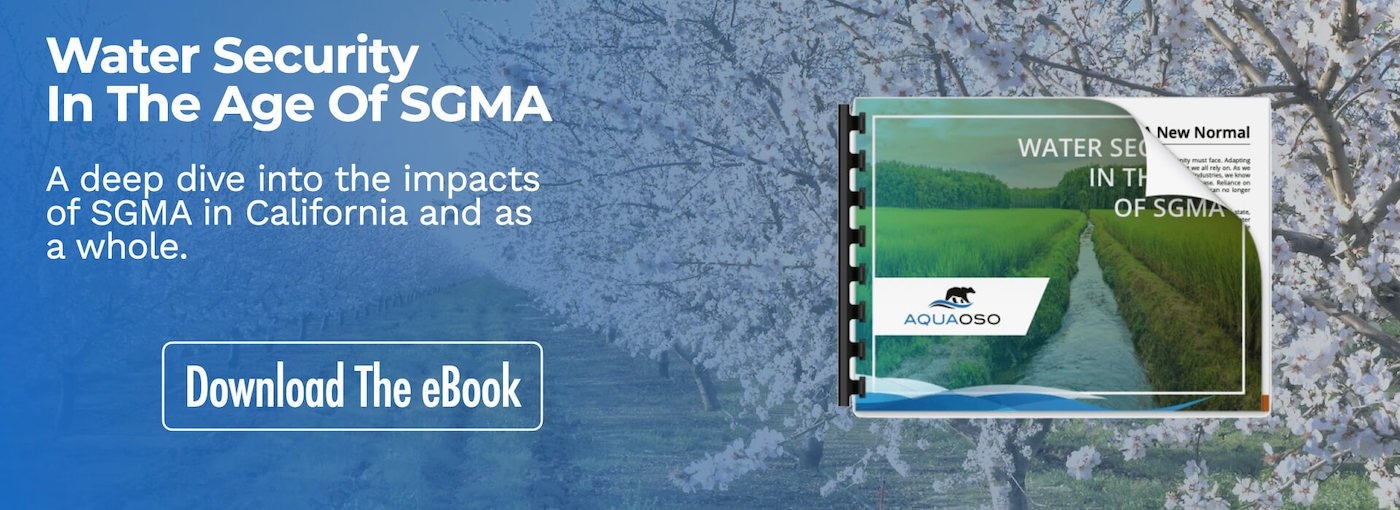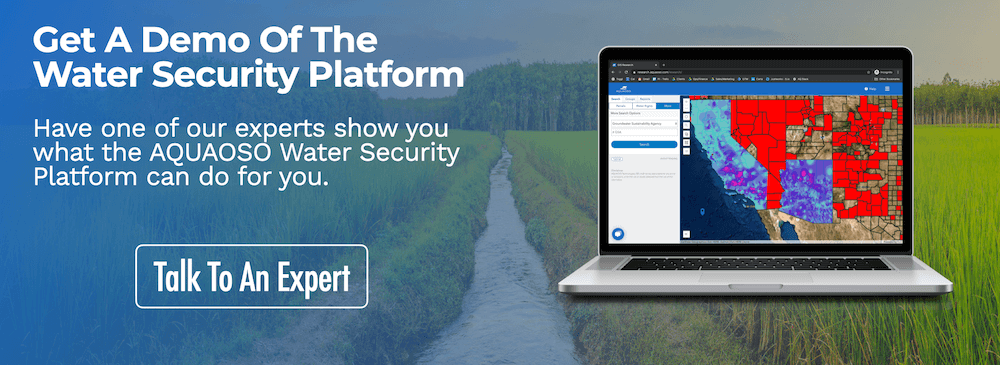The Importance of Water in Agriculture Finance
According to the U.N., demand for food is expected to rise by 50 percent by 2050, which will serve to strengthen the negative results and risks brought on by climate change, such as water scarcity and a loss of biodiversity.
“The annual amount of available freshwater resources per person has declined by more than 20 percent in the past two decades,” the FAO reports. In part, this is due to changing dietary habits; the demand for meat is expected to rise by as much as 73 percent by 2050, which will further stress limited water resources.
However, a food production crisis isn’t inevitable. The agricultural industry is uniquely suited to mitigating water scarcity issues through more sustainable farming practices and technologies – if solutions are invested in wisely.
The world has entered an era where water risk directly translates into business risk and the financial impact of water will be in the trillions of dollars.
This post discusses the role agricultural loans can play in addressing water scarcity issues, the role of water in agriculture finance, and what the future of farming would look like without it.
(Part of our Agricultural Loan Guide)
What If Agricultural Loans Don’t Account for Water Risk?
The importance of water in agriculture finance is hard to overstate. In the U.S., over 80% of consumptive water use is linked to agriculture. That number rises to over 90% in the West, in some of the regions most at risk of drought and water shortages.
In many cases, an obstacle to better water management can be a lack of finance. This includes funding for infrastructure, technology, and farmers and ranchers themselves.
A lack of capital can delay planting and harvesting decisions, potentially disrupting the entire supply chain. Lenders must pay closer attention to water security and factors that can determine the overall risk of a loan. Although climate change has long been on lenders’ minds, water risk is now a major concern as well.
Understanding the impact of water risk on a loan portfolio is a prerequisite to mitigating it. While many banks are increasingly opting to – or being required to – disclose climate risks, water can still represent an unknown risk in many loan portfolios.
In other words, water risk needs more attention than it is currently getting. Water risk is business risk, so it makes sense for agriculture finance to solidify water risk mitigation as part of their repertoire.
Both the public and private sectors should strive for more transparency around water security issues. Because agriculture is so dependent on water, a future in which water in agriculture finance is not accounted for in terms of risk is a dangerous one.
The reason that water risk can be hard to identify is that it encompasses several areas. There’s the physical component – reduced rainfall and depleted aquifers – and related regulatory and economic factors – such as the cost of water in smart water markets, and the impact of regional regulations like SGMA.
There is also a severe dispersion of data. In most cases, water data is siloed, dramatically slowing the process of discovery and data gathering and inhibiting educated decision making.
Farms and parcels of land that don’t have access to sufficient quantities of water make for riskier loans. Farms that may not use sustainable water management practices can also be a risk to an agriculture loan portfolio. As stated in the guide How to Conserve Water in Agriculture, this is a loss not just for agricultural lenders, but for the overall resilience of water resources.
The Role Agricultural Lenders Can Play with Water in Agriculture Finance
Lenders have a key role to play in bringing water security issues to the table. And with access to the latest tools like AQUAOSO’s Water Security Platform, lenders can obtain the data they need to assess a loan with fewer phone calls and consultations.
AQUAOSO actively curates, normalizes, and analyzes data sets from multiple sources, including building original data. The software looks at that data in the context of a specific operation, or across an entire portfolio of loan or real estate assets, and automatically produces risk reports for customers.
Water risk mitigation in agricultural lending isn’t just a matter of short-term security, it’s also a matter of long-term sustainability. According to the World Bank,
“If appropriate risk mitigation products are lacking, or if available financial instruments do not match farmers’ needs, farmers may be discouraged to adopt better technologies, to purchase agricultural inputs, or to make other decisions that can improve the efficiency of their businesses.”
Lenders are well-positioned to become a driving force behind sustainable farming practices such as regenerative agriculture. For example, “Rabo AgriFinance announced a new loan product that aims to make it more financially viable for farmers to seek organic certification on all or part of their crop operations…. Farmers can schedule repayments when they receive the additional revenue from selling certified organic goods.”
Initiatives like these can help farmers and ranchers – who are responsible for feeding the world – become better stewards of the planet and its water resources.
Plus, by bringing water risk into the conversation, lenders can highlight its importance, and demonstrate how better data and analysis can drive lasting change.
Read more about agriculture loans and water risk in this guide.
The Bottom Line
The importance of water in agriculture finance is considerable. Stakeholders are beginning to factor climate risk into their financial decisions, but water security remains a hidden risk for many lenders. Without accounting for water risk, loan portfolios can become liabilities.
But with technologies available to assess and monitor water risk, lenders will have a key role to play in fostering a more secure, water-resilient agricultural sector.
Water risk should never be an afterthought when it comes to agricultural lending. AQUAOSO is committed to providing the information needed to keep water risk mitigation accessible in financial discussions and loan decisions.
The Water Security Platform can help identify and monitor water risk on a parcel by parcel basis. In addition, AQUAOSO offers free resources and a newsletter to help our clients stay up to date on water security issues. Reach out to us today for a free demo or to talk with one of our water experts.
Recent Posts
Agcor and AgWare Celebrate 2 Years of Groundbreaking Integration, Setting the Standard in Agricultural Appraisal Efficiency
PRESS RELEASE For Immediate Release DENVER, March 21, 2024 -- Agcor, an AQUAOSO Technologies, PBC brand, a leading provider of agricultural lending software solutions, announces a significant milestone in its partnership with AgWare, a premier developer of innovative...
AQUAOSO launches Agcor – a full suite of digital tools for the modern ag lender.
PRESS RELEASE For Immediate Release Denver, CO - Today, AQUAOSO Technologies, PBC officially unveiled Agcor™ - a suite of software tools for the modern ag lender. The software is purpose-built by and for agricultural lenders to unlock the power of...
AQUAOSO’s Climate Intelligence Platform Showcased At OnRamp Conference
PRESS RELEASE For Immediate Release AQUAOSO showcases GIS Connect, a climate intelligence platform that helps US financial institutions mitigate climate risk during the recent OnRamp Agriculture conference. AQUAOSO shares their story of substantial growth as...



